It has been nearly half a century since Monty Python released their own unique brand of humor on the world, and it is a bit of an understatement to say that nothing has been the same ever since. The fact that “Pythonesque” is now a word in the dictionary should say something! Graham Chapman (RIP), Terry Jones, Terry Gilliam, John Cleese, Eric Idle, and Michael Palin forever changed the face of comedy, and remain massively influential to this day. Not to mention hilarious.
With John Cleese and Eric Idle coming to Vegas in a few weeks to perform, I thought it would be a good time to look back at the five Monty Python feature films, seeing how they stack up today. For the purposes of this article, we are only looking at the theatrical movies, not the television series, direct to video presentations, specials, documentaries, etc.
Here we will look at the good and bad traits of each film, what parts have held up the best over the years, and what material has not aged so well. Which one is the definitive Monty Python movie? Likewise, which ones remain essential viewing all these years later?
And Now for Something Completely Different (1971)
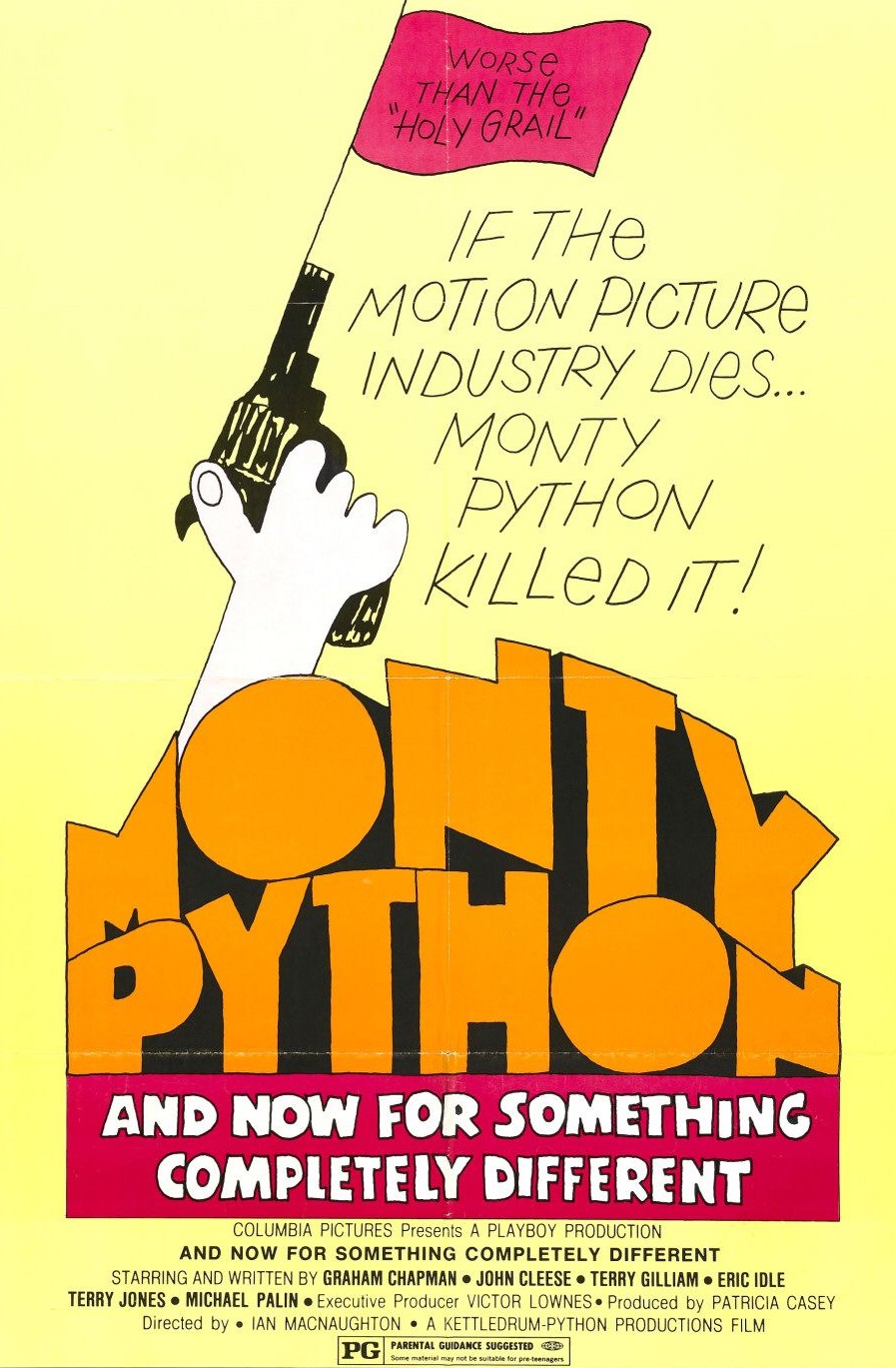
The band’s first feature film, essentially, features refilmed versions of sketches that were written for and performed in the first two series of Monty Python’s Flying Circus. Amongst the sketches that appear in the film are “How Not to Be Seen,” “Marriage Guidance Counselor,” “Nudge Nudge,” “The Dead Parrot,” and “The Lumberjack Song,” as well as a number of animated Terry Gilliam sequences, including “Conrad Poohs and his Dancing Teeth” and “Killer Cars.”
The Pythons were looking to break into the American market, and it was Playboy executive Victor Lownes’ idea that they do so in the form of a feature film. The creation of the film was rocky; the Pythons did not have final cut of the film, and they clashed with Lownes on more than a few occasions. The extremely low budget meant that sketches had to be filmed at an abandoned dairy, rather than the more expensive sound stages traditional films are done on. Ironically, the film did far better in the Pythons’ native UK than in America, where it was released in 1972. It did, however, perform better stateside on a later release, by which time PBS had begun airing the TV series there.
This is a tough film to rate because it is, essentially, rerecorded versions of material that had previously appeared on television, and in this day and age you can easily acquire both this film and the original television sketches on home video. As a general rule, the television versions of these sketches feel more intimate, and have a certain energy about them due to the boisterous, spontaneous laughter of a surprised studio audience. There is no equivalent of that here, and as a result, these refilmed versions cannot quite live up to their television counterparts. There are some pacing issues with a few sketches, though admittedly even the TV show had that problem from time to time. If you own Monty Python’s Flying Circus on DVD, however, you own better versions of the material here.
That said, the film is not a total loss by any means. No one can deny that this is some of the troupe’s best material, brought together in one place. That makes it something of a good “sampler” of their work, and could therefore be a good place to introduce someone to Monty Python’s unique brand of humor. As such, there is still enough to recommend viewing it.
Trivia:
-Originally, all of the Pythons’ names in the opening credits were to have an “engraved in stone” look (not unlike what was later done in Life of Brian). Executive producer Victor Lownes insisted on a similar style credit, and as he had creative control, could not be overruled here. Terry Gilliam created a similar credit for Lownes, but took the Pythons’ names out of this portion of the credits, thus meaning in the final movie, ONLY Lownes has a credit in this style.
-A number of the sketches are modified from their original versions; this is often done so that the sketches can better segue into one another. Another interesting change is the voice that encourages the man to stand up for himself in the “Marriage Guidance Counselor” sketch; it was a cowboy in the original sketch, but in the film version, it is God (heard as a voiceover off camera). In fact, God is the only character that appears in every Monty Python film.
Monty Python and the Holy Grail (1975)
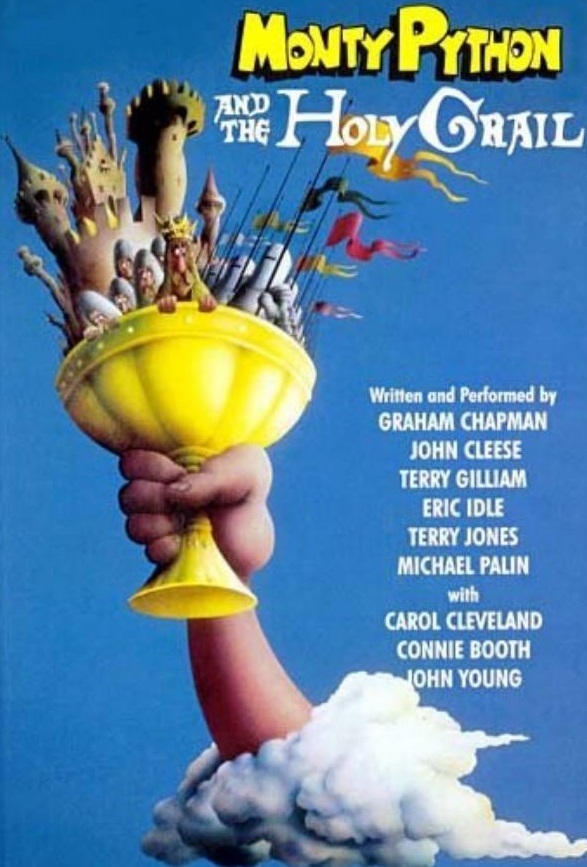
In the troupe’s first film of all original material, King Arthur (Chapman) and his Knights of the Round Table are given a task by God, that of finding the mythical Holy Grail. His band of knights includes the scholarly Sir Bedevere (Jones), the overzealous and unflinching Lancelot (Cleese), and cowardly Sir Robin (Idle). On their quest, the team must deal with threats such as the deadly and equally stubborn Black Knight, a three-headed monster, a palace filled with temptresses, the Knights Who Say Ni, a killer rabbit, and mean spirited French knights. But through it all, will they find the Holy Grail?
As the first all original Python film, this movie had a lot to live up to, especially considering their previous film had tanked on its initial American release. But this movie let the troupe stand up and do their own thing, their own way, with Terry Jones and Terry Gilliam sharing directorial duties. With comical, over the top violence, and the Pythons’ own surreal brand of humor dominating the bulk of the film, it was a resounding success on both sides of the Atlantic. Despite obstacles the team encountered during filming, including not being able to use many of the medieval castles in Scotland they had initially arranged to film in, they overcame these obstacles, even making light of the movie’s low budget in many regards, something that resulted in the now legendary (and downright hilarious) opening credits sequence, and the infamous “coconut” gag that is repeated throughout the film.
While the film is largely individual sketches arranged together into a coherent film with a single storyline, everything comes together nicely. Each of the Pythons plays multiple parts throughout the film, often in the same scene! This would become an ongoing joke in their later movies as well. Just when you think you know what it is coming next, the Pythons throw everything at you, from breaking the fourth wall to anachronistic jokes. The dialogue is just as sharp and witty as the physical gags; it is truly impossible to get through the film without laughing. They even manage to find time for a few choice musical numbers as well.
Monty Python and the Holy Grail is Python at their finest; it just might be their best all around feature film. This is the troupe at their most hilarious and unpredictable; would you expect anything less from them? Easily one of the funniest movies ever made, this one comes highly recommended.
Trivia:
-The plot and characters of this film are the basis for the musical play Spamalot!.
-Terry Jones and Terry Gilliam, who served as the directors, regularly clashed behind the cameras. It was later decided that Jones alone would direct the subsequent Python films.
-Pink Floyd were huge fans of Monty Python, and donated to the budget of this film.
Life of Brian (1979)
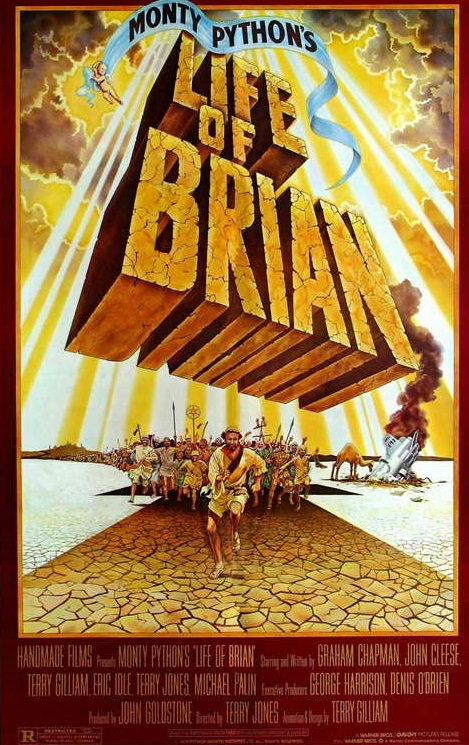
For their third movie and second of original material, the Pythons give the audience another iconic and hilarious story. Born in the same village as Christ, Brian Coen (Chapman) has had to live his life constantly being mistaken for the Messiah, much to the dismay of himself and his crotchety old mother (Jones). Forced to work selling disgusting refreshments at a gladiator arena while living under the Roman occupation, Brian meets a beautiful woman who is part of a revolutionary squad, looking to take the Romans down a notch. He joins up with the revolutionaries and wins their respect, but quickly gains the ire of the Roman Empire. This coupled with his being mistaken for a Messianic figure results in countless frustrations for our hero… and hilarity for the audience.
Even before it was released, Life of Brian was a controversial film. Religious and decency groups believed that the Pythons were creating a film lampooning the life of Jesus Christ, and our heroes quickly found themselves under the scope of many watchdogs. A film studio that was going to back the film even pulled out upon an executive deeming the material “blasphemous.” Of course, this was all taken out of context and blown out of proportion. While the film is outrageously funny and politically incorrect (again, the norm for Monty Python), it does not mock or lampoon the teachings of Christ. (Christ appears in the film giving the legendary Sermon on the Mount, but is depicted in a faithful, kind fashion that is in no way detrimental.) Rather, it mocks the hypocrisy and shallow bases of religion, doing so shockingly well. The film was banned in numerous cities, but this only served to enhance the movie’s popularity, making audiences want to see it more. So much so, that they would even organize bus tours to go to the communities in which it was not banned!
Once again, the late Graham Chapman plays the lead role in the film, and he is excellent as Brian, a confused young man unsure of what direction his life is going in amidst the Roman occupation and the rise of revolutionary groups. As with Holy Grail, everyone plays multiple parts, only adding to the zany atmosphere. At the time of its release this was probably the most raunchy work the Pythons had released, featuring full frontal nudity (both male and female), stronger language, and more mature themes. It was also their first movie to get an R Rating from the MPAA in America (which would be the case for their subsequent movies).
There are a few sequences that feel unnecessary in the grand scheme of things (what the hell is up with that spaceship battle!?) when it comes to Life of Brian, but it still stands as an excellent movie that lets the Pythons be themselves and take their humor to new levels in the time of Christ. Any fan of Monty Python is going to be thoroughly entertained by what they see in this film.
Trivia:
-The Pythons struggled to get the money they needed to make the movie when a previous financier pulled out. George Harrison (of Beatles fame), a huge Python fan, put up the money needed to make the film; he established the company Handmade Films for this endeavor. Via Handmade, Harrison did the same for a number of other movies, including some non-Python movies involving the Pythons, one of which being Terry Gilliam’s directorial effort Time Bandits. Harrison cameos briefly in Life of Brian, but his one word cameo was actually dubbed over.
-John Cleese expressed interested in playing Brian; he wanted to be a lead character that lasted from the beginning to the end of the movie. However, he later expressed satisfaction with the way things turned out, and believed Graham Chapman had been the better man for the role.
-In the Sermon on the Mount scene, Jesus Christ is portrayed by Kenneth Colley. Colley is well known to Star Wars fans as the actor that portrayed Imperial Admiral Piett in The Empire Strikes Back and Return of the Jedi.
Monty Python Live at the Hollywood Bowl (1982)
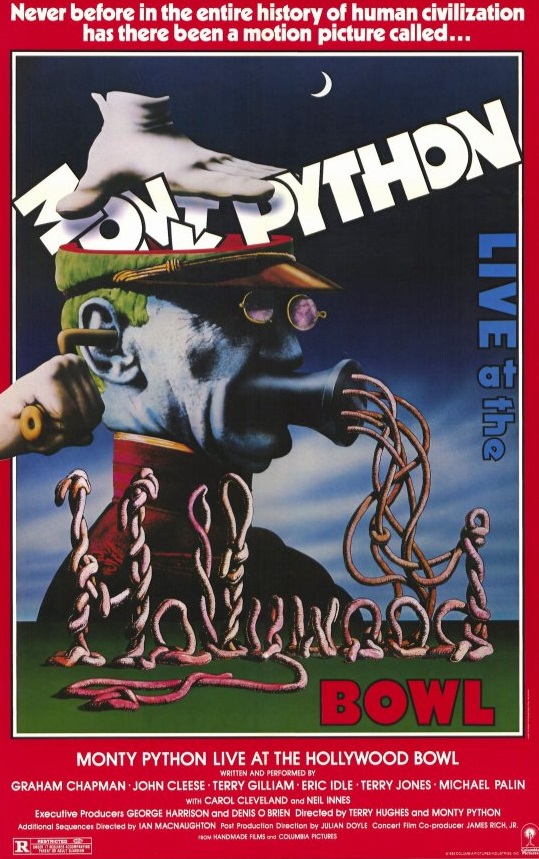
This time around, the Pythons are up to their old tricks, live on stage at the legendary Hollywood Bowl! The gang is all here, with the Pythons performing their best classic Flying Circus sketches, other related sketches from other programs they had appeared on, routines from their comedy albums, songs, and even some musical interludes from longtime Python collaborator Neil Innes. Unbridled and without reservations or censorship of any kind holding them back, all hell breaks loose on stage, much to the delight of an enthusiastic audience.
What if you could get the Pythons and their closest collaborators to perform all of their best material in one 80 minute set, with no censorship requirements, and non-stop laughs? If you did, this movie is what you would end up with. Unflinching and lightning fast with the laughs, this live show takes the best of Monty Python and supercharges it all. John Cleese doing his famous “Silly Walks.” “Sit on My Face” sung as a barbershop quartet number. Terry Jones singing an opera song with racial slurs galore. The definitive version of the classic “Four Yorkshiremen” sketch, with the Pythons trying to outdo each other with tales of rough childhoods. The argument clinic. And even a few unexpected surprises.
One great thing about this set is that the troupe performs many of the routines from their comedy albums that were never performed on television. The familiar routines are improved by the fact that the Pythons do not have the BBC censors looming over their heads, which definitely results in a few more shocks, but it just makes the material all the more funny. Additionally, much of the material played over the video screens (done during transitions between sketches/sets) was originally done for German television, meaning this is the first time it was dubbed for English audiences. Even the usually reclusive Terry Gilliam gets a lot to do on stage this time around.
This truly feels like a live show, with all of the flubs and “screw ups” left intact; there are plenty of moments with the Pythons trying their hardest to stifle their laughter, in fact. These things just add to the overall experience and value of it all.
It is not a perfect set, however. Portions of it do tend to drag; the “Comedy Lecture” sketch being a notorious offender in this regard (not to say said sketch is not funny). There are also some major missing moments from the television series that come as quite a surprise; where are “Dead Parrot,” “Spam,” and “The Spanish Inquisition?” That said, everything we DO get to see is absolutely priceless. As far as the performance of traditional sketches and the like goes, this is Python at their absolute strongest. The unpredictable, uncensored nature of the set and even things like the live flubs just add to the charm of the overall experience. No Python fan should pass this one by.
Trivia:
-This show is actually a compilation of multiple shows shot over the course of several nights, using the best possible footage from each.
-Still photographs exist of Carrie Fisher and Deborah Harry (of Blondie fame) backstage at these performances.
-Neil Innes performs two songs in the show, “I’m the Urban Spaceman” and “How Sweet to Be an Idiot.” It is strange that the group does not perform material from Monty Python and the Holy Grail at this show, as Innes wrote the music for the film, and even appeared in it in several roles, the most noteworthy of which being Sir Robin’s Minstrel.
The Meaning of Life (1983)
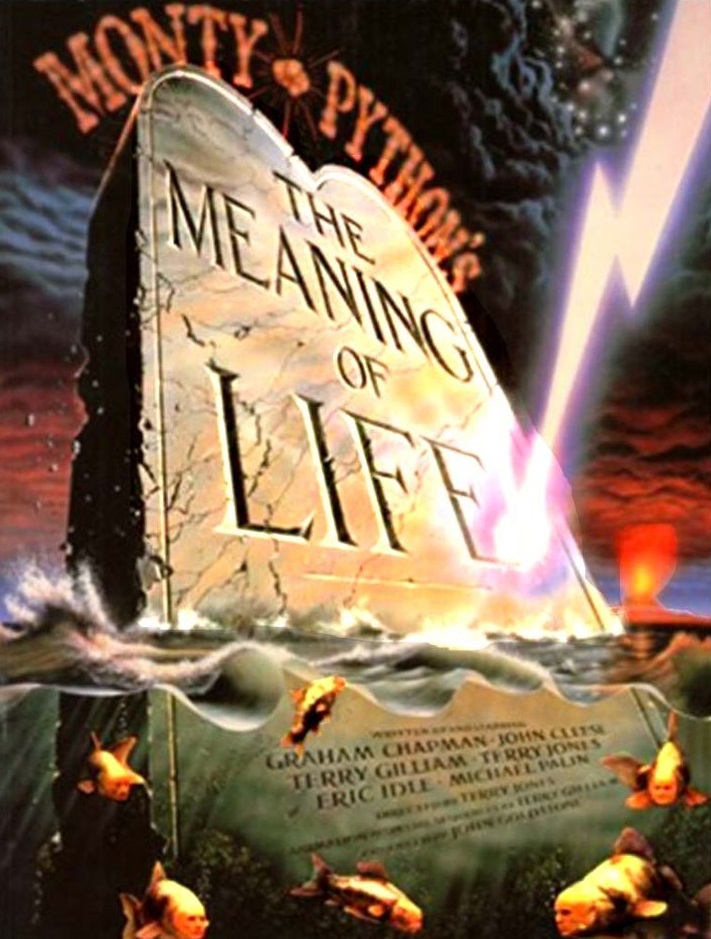
The Pythons tackle another weighty subject in their fifth and final film, although the loose narrative results in them returning to their sketch comedy roots. Sketches seen in the movie entail the various stages of life, from being born, overpopulation in the third world, childhood and education, people at war, and the autumn years. The stages are viewed in the form of characters that include a Catholic couple with an overabundance of children, a very hands-on sexual education instructor, British soldiers fighting in a Zulu War, organ transplant men, a morbidly obese man who vomits profusely, eccentric waiters, and even the Grim Reaper himself!
The film is started off with a 15 minute (approximately) short entitled The Crimson Permanent Assurance, which was directed by Terry Gilliam, using a unit separate from the main movie. This short film features aging men working in an office environment, who use unconventional methods to strike back at their corporate slavers.
Okay, let’s get the bad news out of the way first; The Meaning of Life is the most uneven and inconsistent of all the Monty Python movies. It is the one movie of theirs that could truly be defined as a “hit and miss” effort; the “hits” rank amongst their absolute best efforts, while the “misses” are largely forgettable, but may be worth checking out at least once for the curious nonetheless.
Gilliam’s The Crimson Permanent Assurance is a brilliant idea with a few hilarious moments, but unfortunately, the short wears out its welcome rather quickly, robbing it of the impact it would have had if it had been a more concise piece. That said, one must admire the production values here; it still manages to feel like a “mini-film” of its own. Gilliam, of course, would go on to become a noteworthy director beyond the Pythons, with films like Brazil and Fear and Loathing in Las Vegas.
As for the main body of The Meaning of Life, the lack of a conventional, singular narrative means that this feels more like an extended episode of Monty Python’s Flying Circus than a true movie. And like a Flying Circus episode, there are hits and misses. Sheer brilliance comes through in many sequences, including the classic “Every Sperm is Sacred” musical number, an authentic sexual education demonstration, Eric Idle singing numbers like “Galaxy Song” and “Penis Song,” and the bombastic “Christmas in Heaven” outro. The “Mr. Creosote” sketch takes gross-out humor to new highs (or lows, depending on how you look at it). When The Meaning of Life shines, it features the Pythons at their most brilliant.
Unfortunately, there are a lot of duds in the mix too. The “Zulu War” sequence drags and really does not accomplish too much; few of the jokes there manage to stick. The gag with the Pythons as fish is something the film seems intent on building up as well, but the narrative just never does anything with it, much to the disappointment of the audience. Fortunately, in true Python fashion, the good exceeds the less than stellar.
The Pythons may not have achieved another masterpiece with The Meaning of Life, but its better parts are certainly worth the price of admission; you will not be able to get “Every Sperm is Sacred” out of your head after you have finished watching the film. This one is for the Python die-hards only, but there is certainly reason enough to watch.
Trivia:
-A lengthy segment entitled “The Adventures of Martin Luther” was excised from the final film.
-Additional footage of Mr. Creosote was filmed, including him arriving at the restaurant.
-Jane Leeves, later known as Daphne on the hit sitcom Frasier, appears in the “Christmas in Heaven” sequence, as one of the costumed dancers.
-Unbeknownst to the rest of the cast and crew, Terry Jones used most of the budget on the “Every Sperm is Sacred” sequence!
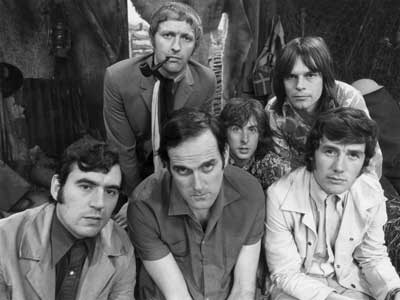
So, after looking at the individual films, how would this Python fan rank them? This is never an easy thing to do, but I shall do my best…
5) And Now for Something Completely Different
This one comes in last simply because it is comprised of inferior versions of sketches from the television series; there is really nothing new or original contained within. Given its nature as a promotional piece to try to launch them into American fame, this is understandable, but even then it still has plenty of strong moments, and is a nice “sampler” to introduce someone to Monty Python.
4) The Meaning of Life
Wild and uneven but still damn funny in more than a few places, this is not the Pythons’ finest hour, but there is more than enough content here to have you laughing. Moments like “Every Sperm is Sacred” and “Mr. Creosote” still manage to rank amongst the most iconic and memorable in the Python canon.
3) Life of Brian
The Python crew had to overcome many obstacles to make this movie, and the ire of nearly every religious watchdog group out there. But the end result was one of their most accomplished efforts, with incredible production values, the team playing various hilarious roles throughout the film, and a surprise Eric Idle musical outro that has become a classic for the ages.
2) Monty Python at the Hollywood Bowl
If you want nonstop laughter, this live set from 1980 will fit the bill nicely. No, the production is nowhere near as high as their “proper” feature films, but the uncensored nature of the material and the lightning fast jokes and surprise musical numbers all come together nicely. The fact that I am ranking this so highly should say something; it is definitely Monty Python at their absolute best. But of course, the number one film is…
1) Monty Python and the Holy Grail
This was the first foray of the Pythons into making a feature film of original material. Four plus decades on, many would argue that it is their best work despite the low budget. Even before the movie starts, the surprises in the opening credits will get you warmed up. And then comes the Black Knight getting dismembered by King Arthur. The “Knights of the Round Table” musical number. John Cleese’s Sir Lancelot rushing to a young prince’s rescue and (literally!) killing everyone in sight. Tim the Enchanter. The Killer Rabbit. There is never a dull moment with the Pythons take on medieval times, and it is because of these classic moments galore that Monty Python and the Holy Grail stands as their finest film.
–
With John Cleese and Eric Idle coming to Vegas, what better time is there than now to quench your thirst for more Monty Python?
DISCLAIMER: All images in this review are the property of their respective copyright holders. For promotional use only. All rights reserved.

